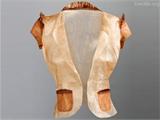Until the skin fully absorbs it
Author: Butterfly Yulan Picture Origin: Internet collection, health care
We face computers every day, exposed to radiation, staying up late, and using our eyes excessively... All of these put a lot of pressure on our eyes. Therefore, many young women experience various eye issues, the most common being dark circles and eye bags.
Hence, most women use eye cream to nourish the delicate skin around their eyes and alleviate problems that arise.
It is well known that the skin around the eyes is very thin and extremely delicate. If eye cream is used improperly—such as choosing the wrong cream, incorrect technique, or applying too much force—it can cause significant damage to the skin around the eyes. This not only fails to solve the problem but could also backfire, leading to "disfigurement."
Therefore, selecting an eye cream suitable for yourself is extremely important, and the application technique is equally critical.
Before choosing an eye cream, you should first examine your own eye skin and identify the specific issue before using targeted products.
Eye creams come in various types (Note: The eye creams shown in the images in this article are merely examples).
For instance, moisturizing, anti-wrinkle, whitening/removing dark circles, tightening/reducing eye bags, etc. When choosing an eye cream, it's essential to target the specific problem, but sometimes one eye cream alone cannot solve all issues.
How to choose different functional eye creams:
Anti-allergy eye cream - the first choice for sensitive-skinned women.
Moisturizing eye cream - with strong hydrating properties, suitable for autumn/winter seasons and those working in air-conditioned rooms.
Firming eye cream - rich in nourishing ingredients, higher oil content than moisturizing creams, suitable for women with dark circles, aging, or dry skin.
Anti-aging eye cream - with anti-wrinkle and sun protection functions, suitable for summer and screen workers.
Selecting the right eye cream is just the first step; another crucial step is applying the eye cream correctly.
PS:
Some women may notice small white fat granules appear under their lower eyelids after using eye cream. This does not necessarily mean the eye cream is too oily or incompatible with your skin. Sometimes, it's due to improper technique or over-application. Thus, correct application of eye cream is also important.
Massage techniques to promote eye cream absorption:
First, apply the eye cream evenly around the eyes, then gently massage in the order of inner corner - upper eyelid - outer corner - lower eyelid (as shown in the diagram) until the skin fully absorbs the cream. You can also press related acupoints around the eyes for enhanced results. Additionally, daily living habits are also very important, such as avoiding squinting, not staying up late, and staying away from radiation and computers as much as possible.
Common misconceptions when using eye cream:
A. Eye cream is only for crow's feet, eye bags, and dark circles.
Most people use eye cream because they have eye problems—such as the first fine line at the corner of the eye, swollen eyelids, or obvious dark circles or eye bags. This is akin to trying to fix something after it has already broken.
The causes of eye wrinkles include two points (this section is more technical, specifically gathered from online resources):
1. The epidermis becomes dry and thin.
2. The dermis layer beneath loses its mesh support. The dermis layer is like a fine sieve made up of collagen and elastin fibers. As collagen and elastin proteins gradually disappear, the mesh becomes finer and more fragile, even breaking, resulting in uneven wrinkles. If the skin around the eyes further ages, the skin separates from the underlying tissue, and subcutaneous fat shifts downward, causing eye bags and drooping eyelids. Since the skin around the eyes is extremely thin and delicate, it easily becomes nutrient-deficient and blood-supply insufficient due to fatigue, lack of sleep, stress, etc., leading to dark circles.
Therefore, you should start using eye cream before wrinkles, eye bags, and dark circles appear. Otherwise, once the cause turns into the effect, addressing the effect will be too late.
B. Using eye cream only at the corners of the eyes.
Since the earliest wrinkles usually appear at the corners of the eyes as three crow's feet lines, people often use eye cream to massage vertically against the wrinkles at the corners of the eyes, which is undoubtedly correct. However, the area below the eyes and the upper eyelids are the first to become loose and aged. Although this area doesn't develop crow's feet, it is more fragile. The correct way to use eye cream is to perform circular massages following the order of inner corner - upper eyelid - outer corner - lower eyelid, allowing the skin to fully absorb the cream.
C. Only using eye cream after age 25.
Nowadays, cosmetics are becoming increasingly detailed and professional.
Some cosmetic products are not necessary, such as makeup items, while others are highly targeted, such as anti-acne cleansers.
However, eye cream is essential for most people. Due to excessive eye usage, environmental pollution, and seasonal factors, young women aged 18-24 should also cultivate the habit of using eye cream.
D. All eye creams are the same.
Many women, realizing the importance of eye cream, often go to cosmetics counters and pick those with good reputations, attractive packaging, and high prices.
However, today's eye creams come in many varieties, each designed for different eye issues, different ages, and individual conditions. Therefore, it's important to carefully read the instructions, understand your eye issues and seasonal factors, and purchase according to need. This ensures effectiveness rather than blindly treating symptoms without targeting the root cause, which could lead to wasted effort.
E. Face cream can replace eye cream.
A considerable number of women might think that eye cream and face cream are the same thing—that eye cream is just more refined, higher-end, and more expensive. In reality, the skin around the eyes and the facial skin are entirely different. The skin around the eyes has the thinnest stratum corneum and the fewest sebaceous glands. Simultaneously, the skin around the eyes experiences the most frequent movement and is subjected to the most complex makeup processes, involving repeated pulling of the skin. The anatomical structure of the skin around the eyes dictates the need for skincare products entirely different from face cream. Therefore, face cream absolutely cannot replace eye cream.
As we can see, the selection, use, amount, and techniques of eye cream all have specific scientific methods. It is hoped that all women can choose the right eye cream for themselves and truly address their eye-related issues.



